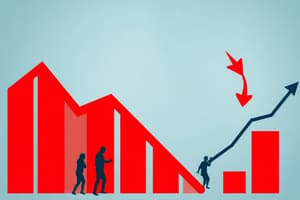Podcast
Questions and Answers
What is the straight line drawn through the business cycle curves?
What is the straight line drawn through the business cycle curves?
The Growth trend
A recession is a decline in:
A recession is a decline in:
- The inflation rate that lasts six months or longer
- The unemployment rate that lasts six months or longer
- Potential GDP that lasts six months or longer
- Real GDP that lasts six months or longer (correct)
The best example of a frictionally unemployed worker is one who:
The best example of a frictionally unemployed worker is one who:
- Is laid off during a recessionary period in the economy
- Is in the process of voluntarily switching jobs (correct)
- Is discouraged and not actively seeking work
- Reduces productivity by causing frictions in a business
The natural rate of unemployment:
The natural rate of unemployment:
When inflation occurs:
When inflation occurs:
What are business cycles?
What are business cycles?
What is a peak in the business cycle?
What is a peak in the business cycle?
What is a recession?
What is a recession?
What is a trough in the business cycle?
What is a trough in the business cycle?
What is an expansion in the business cycle?
What is an expansion in the business cycle?
What does the labor force consist of?
What does the labor force consist of?
What is the unemployment rate?
What is the unemployment rate?
What is part-time employment?
What is part-time employment?
Who are discouraged workers?
Who are discouraged workers?
What is frictional unemployment?
What is frictional unemployment?
What is structural unemployment?
What is structural unemployment?
What is cyclical unemployment?
What is cyclical unemployment?
What is the natural rate of unemployment (NRU)?
What is the natural rate of unemployment (NRU)?
What is potential output?
What is potential output?
What is the GDP gap?
What is the GDP gap?
What is Okun's Law?
What is Okun's Law?
What does full employment mean?
What does full employment mean?
What is inflation?
What is inflation?
What is the Consumer Price Index (CPI)?
What is the Consumer Price Index (CPI)?
What is deflation?
What is deflation?
Flashcards are hidden until you start studying
Study Notes
Business Cycle Concepts
- The Growth Trend represents the straight line through business cycle curves, indicating potential economic growth over time.
- Business Cycles refer to alternating rises and declines in economic activity over several years.
- Key phases of the business cycle include Peak, Recession, Trough, and Expansion:
- Peak: Economy is at or near full employment, with real output close to capacity.
- Recession: A period marked by a decline in total output, income, and employment, lasting six months or more, characterized by decreased real GDP.
- Trough: The lowest point in the business cycle, where output and employment bottom out; marks the transition from recession to expansion.
- Expansion: A phase where real GDP, income, and employment increase.
Employment and Unemployment Paradigms
- The Labor Force includes individuals who are willing and able to work, comprising both employed and actively seeking unemployed individuals.
- Unemployment Rate is calculated as (unemployed/labor force) x 100, representing the proportion of the labor force without jobs.
- Natural Rate of Unemployment (NRU) reflects full-employment conditions with no cyclical unemployment, indicating the rate where inflation aligns with expectations.
Types of Unemployment
- Frictional Unemployment: Results from workers voluntarily changing jobs or being temporarily laid off, representing a normal transition in employment.
- Structural Unemployment: Occurs when workers' skills do not meet job demands or they cannot relocate to areas with job openings.
- Cyclical Unemployment: Caused by insufficient demand or total spending in the economy.
- Discouraged Workers are individuals who have left the labor force due to unsuccessful job searches.
Economic Outputs and Gaps
- Potential Output is the maximum real GDP an economy can produce while fully utilizing its resources.
- GDP Gap calculates the difference between actual GDP and potential GDP, represented as actual GDP minus potential GDP.
- Okun's Law indicates that a 1% increase in actual unemployment above the natural rate corresponds with a 2% negative GDP gap.
Inflation and Price Indices
- Inflation signifies a general rise in price levels, leading to a decrease in money's purchasing power.
- Consumer Price Index (CPI) measures the price variation of a fixed "market basket" of approximately 300 goods and services, reflecting typical consumer expenditure.
- Deflation is identified as a decrease in the general price level, contrary to inflationary trends.
Studying That Suits You
Use AI to generate personalized quizzes and flashcards to suit your learning preferences.




